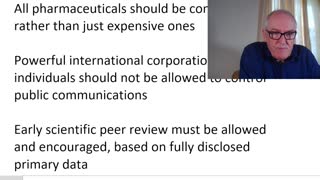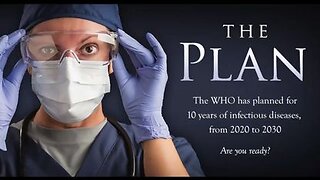Event 201 planning the pandemic.
Event 201 was a high-level pandemic exercise held in October 2019 that simulated a hypothetical global outbreak of a novel coronavirus, which was named "CAPS" (Coronavirus Associated Pulmonary Syndrome) for the purposes of the exercise. The event was hosted by the Johns Hopkins Center for Health Security in partnership with the World Economic Forum and the Bill and Melinda Gates Foundation.
The simulation brought together experts in public health, government, and industry from around the world to explore the potential consequences of a severe pandemic, including its impact on public health, economies, and global stability. The exercise identified key policy and operational gaps that would need to be addressed in the event of a real pandemic.
It is important to note that Event 201 was held prior to the COVID-19 pandemic, and while some aspects of the exercise were similar to the actual outbreak, it was claimed "not intended to predict or model the COVID-19 pandemic specifically."
Event 201 was funded by the Bill and Melinda Gates Foundation, along with the Open Philanthropy Project. It was hosted by the Johns Hopkins Center for Health Security in partnership with the World Economic Forum.
The exercise took place on October 18, 2019, in New York City, and lasted for approximately 3.5 hours. Participants included representatives from government, industry, and public health organizations from around the world, including the World Health Organization, the US Centers for Disease Control and Prevention, and the Chinese Center for Disease Control and Prevention, among others.
During the exercise, participants worked through a hypothetical scenario in which a novel coronavirus, called "CAPS" (Coronavirus Associated Pulmonary Syndrome), was spreading rapidly around the world, leading to a global pandemic. The scenario was designed to test the participants' ability to respond to the outbreak, including their ability to track the spread of the disease, develop and distribute vaccines and treatments, and communicate with the public about the risks and recommended actions.
Throughout the exercise, participants identified key gaps in pandemic preparedness and response, including the need for more coordinated international action, improved communication and transparency, and increased investment in vaccine and treatment development. The findings from the exercise were published in a report by the Johns Hopkins Center for Health Security, which has been used to inform pandemic preparedness efforts around the world.
The governments that participated in Event 201 were fictional and were not based on any specific real-world countries. The scenario of the exercise was designed to be a hypothetical global outbreak of a novel coronavirus, and the participants represented a range of organizations, including public health agencies, non-governmental organizations, and private companies.
However, some of the participating organizations did have government ties, such as the US Centers for Disease Control and Prevention and the Chinese Center for Disease Control and Prevention. The exercise was intended to bring together a diverse group of stakeholders from around the world to explore the potential consequences of a severe pandemic and to identify key policy and operational gaps that would need to be addressed in the event of a real pandemic.
Event 201 was a global exercise that involved participants from around the world. The exercise brought together experts in public health, government, and industry from various countries to explore the potential consequences of a severe pandemic, including its impact on public health, economies, and global stability.
While the exercise was hosted by the Johns Hopkins Center for Health Security, which is based in the United States, and some of the participating organizations were based in the US, there were also participants from other countries. Some of the organizations that participated in the exercise were based in China, Japan, Brazil, Europe, and Africa, among others.
The global nature of the exercise was intentional, as it aimed to explore the potential impact of a pandemic on a global scale and to identify the key challenges and opportunities for collaboration across countries and regions.
The Event 201 exercise brought together participants from a range of countries and regions, reflecting the global nature of the pandemic threat. Some of the countries and regions represented at the exercise included:
1. China: The Chinese Center for Disease Control and Prevention (CDC) was one of the participating organizations in the exercise. This was particularly relevant, given that the COVID-19 pandemic originated in China.
2. United States: The exercise was hosted by the Johns Hopkins Center for Health Security, which is based in the US, and several US government agencies, such as the US Centers for Disease Control and Prevention (CDC) and the Department of Health and Human Services (HHS), were also involved.
3. Brazil: The Oswaldo Cruz Foundation, a public health research institution based in Brazil, was one of the participating organizations in the exercise.
4. Europe: Several European organizations participated in the exercise, including the European Centre for Disease Prevention and Control, the World Health Organization (WHO) Regional Office for Europe, and the UK National Health Service (NHS).
5. Africa: The Africa Centres for Disease Control and Prevention, which is based in Ethiopia, participated in the exercise, reflecting the importance of pandemic preparedness in Africa.
-
 2:44
2:44
InnerLight
1 year agoThe Next Pandemic: SEERS 2025 - Catastrophic Contagion, The Event 201 Sequel - December 11, 2022
30.6K22 -
 16:10
16:10
We The People - Constitutional Conventions
1 year agoPlandemic 2 Catastrophic Contagion! SEERS 2025 They're Planning To Unleash On Us!
5.97K8 -
 0:35
0:35
NovilloLapeyra
1 year agoTIME - This Emergency Is Over. Now It's Time to Get Ready for the Next Pandemic (MAY 11, 2023)
58 -
 6:19
6:19
Kagens Looking Glass
1 year agoWhat You Need to Know About the WHO's New Pandemic Plan
30 -
 1:48
1:48
(NurembergTrials.net)
1 year agoWHO MEETING FEBRUARY 27TH ON PANDEMIC PLANNING BY BAAL & MELINDA GATES FOUNDATION (4THREICH.COM)
321 -
 1:45
1:45
Uncensored Storm
1 year ago10.23.22 | Catastrophic Contagion: The New Event 201 Pandemic Exercise
4497 -
 11:45
11:45
drstellamd
1 year agoEvent 201 | A Global Pandemic Exercise
16 -
 12:24
12:24
Dr. John Campbell
1 year agoLearning from the Pandemic
2.38K70 -
 38:36
38:36
Not MSM
1 month agoHow solid is the data underlying the "pandemic preparedness" agenda?
34 -
 31:06
31:06
Prevent Global Genocide
8 months agoTHE PLAN – Proof the WHO planned for 10 years of pandemics, from 2020 to 2030.
541